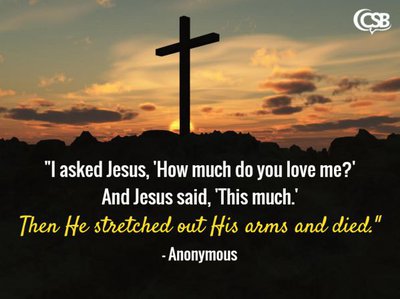Thoughts for the Day
Friday, 15th April 2022: Holy Week images - 5
Jesus John 19 Pilate Cross
Reading : Verses from John, Chapter 19

So they took Jesus and carrying the cross by himself, he went out to what is called The Place of the Skull, which in Hebrew is called Golgotha. There they crucified him, and with him two others, one on either side, with Jesus between them. Pilate also had an inscription written and put on the cross. It read, ‘Jesus of Nazareth, the King of the Jews.’ Many of the Jews read this inscription, because the place where Jesus was crucified was near the city; and it was written in Hebrew, in Latin, and in Greek. Then the chief priests of the Jews said to Pilate, ‘Do not write, “The King of the Jews”, but, “This man said, I am King of the Jews.”’ Pilate answered, ‘What I have written I have written.’
(Readings this week reflect the order of events that happened during Holy Week, and are based on the New Revised Standard Version of the Bible)
Thoughts
We often take the image of the cross for granted. The Jews as a subject nation, were forbidden by the Romans to execute prisoners. This power was reserved for the Roman Procurator, so the Jewish authorities needed to make a charge against Jesus that would ensure that Pilate pronounced the death penalty.
Roman themselves could not be crucified, this death was reserved for slaves and convicts. Jews would normally have condemned someone to death by stoning. Leviticus 24.16 says 'One who blasphemes the name of the Lord shall be put to death; the whole congregation shall stone the blasphemer.' However, Pilate would have thrown such an accusation out calling it an internal religious matter, so the religious leaders needed to manoeuvre Pilate into making a sentence of death. They firstly accuse him of being no friend of Ceasar, then declare Jesus has said he is a king and that they 'have no king but the Emperor', thus denying God as their only true King. Eventually backed into a corner Pilate hands Jesus over to be crucified.
The awful thing about crucifixion was the length of time it could take. Roman law decreed that the criminal must stay until he died from hunger, thirst, or exposure, then the body was thrown away for the dogs and vultures to devour. But under Jewish law the body must be buried, and because the Sabbath approached this had to be done fast.
Today, can we stop to think how our Lord suffered? Can we look at the picture above or another, and meditate on what happened on that day. May we imagine the sights and the sounds as Jesus carried his cross through the narrow streets of Jerusalem, the distress of his family and disciples, the pain and anguish, and the final cry of 'It is finished'? And may we reinstate the cross in its rightful place as our primary icon of self-giving love?
Prayer
Lord Jesus Christ,
You suffered death because
men and women were unable
to accept the offer of God's love.
May we not crucify You again
this Good Friday,
through our thoughtlessness,
our selfishness,
or our wilful ignorance.
May we accept Your offer
of eternal love this day.
Amen.
Here is a very old hymn, not perhaps well known today, but it captures the night in the garden before Jesus' arrest beautifully. The words are attributed William Bradbury:
Or this hymn - the words are attributed to St. Bernard of Clairvaux (1153), translated from Latin by James W. Alexander (1830), music: "Passion Chorale," Hans L. Hassler (1601), harmony by Johann Sebastian Bach (1729):